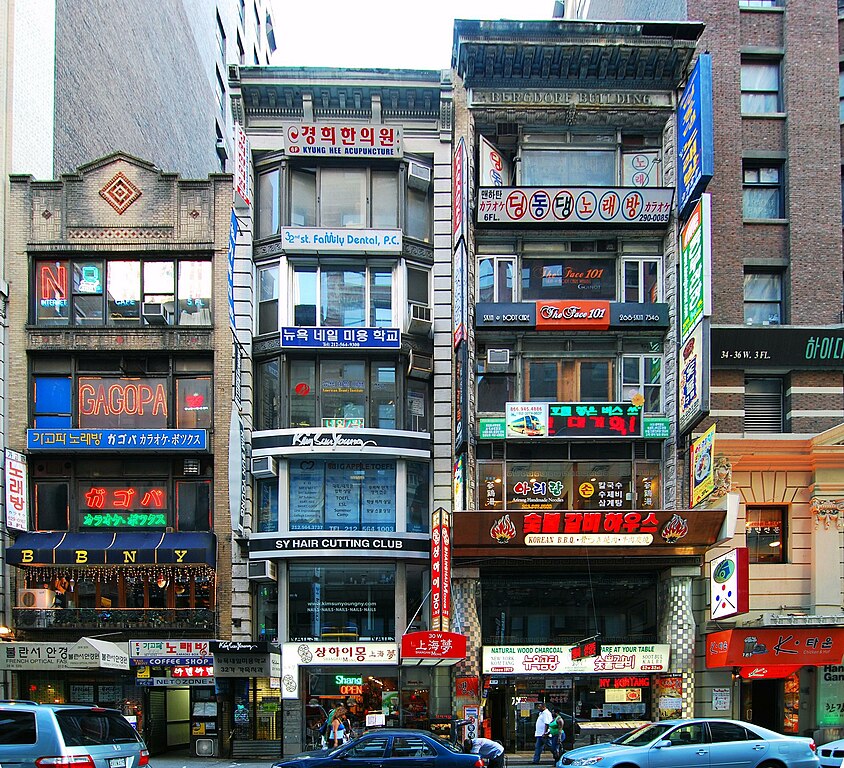Maybe you’ve heard of K-pop. Maybe you’re even a fan. Or your daughter. But have you heard of K-Town? No, it’s not a superstore full of K-pop merchandise in the middle of Times Square.
K-Town is a neighborhood in the middle of Times Square. Well, close. K-Town is the cool kids abbreviation for Koreatown. What people in the know in New York City call it, with their ‘too busy to say the full name’ lifestyle.
Koreatown is a microzone with a brief history dating back to the 1980s. This article will explore the history of Koreatown in a hot BBQ minute, but first…
Is Koreatown safe? Being smack dab in the middle of arguably the most heavily trafficked tourism hub in the world, there’s reason to be concerned about safety and whether K-town is a good place to raise your kids.
Where Exactly Is Koreatown?
Koreatown is more of a strip than a town. It runs along 32nd Street in Manhattan, spanning from the East to the West Sides. From Madison Avenue to the intersection of Sixth Avenue and Broadway, otherwise known as Greeley Square.
For those of you who don’t know one of the most well-known facts in the world, New York City comprises five boroughs. The heart of New York City is Manhattan, a borough but also an island. Manhattan is where you’ll stumble into Times Square.
Koreatown is officially classified as a part of the area of Manhattan known as Midtown South and before evolving into K-town, the area belonged to the Garment District.
The hub of Koreatown is the portion that runs from Fifth to Sixth Avenue, a section named ‘Korea Way.’ Don’t mix up this K-town with the other Koreatowns in the greater New York region! There’s a Koreatown, Long Island, which is actually in Queens. There is also a Koreatown in Fort Lee and Pacific Palisades.
Also, when googling, be aware there is also a Koreatown in Los Angeles, which is much bigger and tends to come up first in searches.
How did Koreatown Begin?
The growth of Koreatown began in the 1980s thanks to a few Korean businesses opening. A bookstore and some restaurants. The businesses benefited from the foot traffic coming from nearby tourist landmarks Times Square, the Empire State Building and the United Nations Headquarters.
Commercial growth followed and the population in the area doubled between 2000 and 2010, helped by immigration and an expanding commercial presence. It is the core center of a population of over two hundred thousand Koreans in the greater metropolitan region and is often referred to as the ‘Korean Times Square’.
These days more than one hundred and fifty businesses are operating in Koreatown! More on that later. The neighborhood has continued to expand since 2015.
What Kind Of People Live In Koreatown?
The population of Koreatown is close to seven thousand people. The median age in Koreatown is early to mid-thirties. The gender ratio is fifty-three percent female to forty-seven percent male.
Koreatown has a solid concentration of entrepreneurs amongst its workers, including both blue and white collar workers, although the percentage of white collars is significantly higher than blue.
The median household income is decent, clocking in at one hundred fifteen thousand annually, with the average closer to one hundred seventy-three thousand USD. Only about thirteen percent of the K-town population lives below the poverty line.
The average hourly pay rate in Koreatown is seventy-nine dollars an hour, with a high of ninety-two USD and a low of sixty-eight USD.
How Is The Real Estate in K-Town?
The average rent for a studio or one-bedroom is close to three thousand USD a month, which is not bad considering you’re in the middle of Manhattan, the most expensive of all five boroughs. The ritzier apartments on the East Side of Koreatown can get up to 5K.
Koreatown is overwhelmingly dominated by renters, with seventy-nine percent renting their living space, as opposed to just twenty-one percent of Koreatown residents who own their home.
Property value in Koreatown is over one million USD. The median home price is around 1.6m. That’s for a studio or 1 bedroom. A two-bedroom can get over two and a half million. Guess that extra half is for the 1-bath.
About 88% of housing units in Koreatown are occupied, either by a renter or an owner.
Getting Around K-Town
K-Town is considered an extremely walkable area. In most reviews, K-town gets a score of 99 for walkability. With walkability comes higher noise and activity levels, so keep that in mind.
Really, K-town is such a tiny district there is no reason to use any other form of transportation besides your own two feet, except for cycling. Cycling also receives a high score in Koreatown.
If you need to get to other parts of the city, you’re in luck! Being so central and spread across the East and West Side, you have easy, very walkable access to most major subway and bus lines, many of which have to cross the hub on their everyday routes.
The commute downtown to Wall Street is just twenty-five minutes by public transit. Getting to Rockefeller Center by public transit is just fifteen minutes. But again, you might as well walk. It’s what a real New Yorker would do!
And if you need to get out of the city, the luck stays with you! On the East Side, you have the legendary and historic Grand Central Station, which is worth visiting even if you have nowhere to go.
On the West Side, you can pop into Penn Station for transportation to places outside of the five boroughs.
What To Do In Koreatown?
So much! Remember? There are over 150 businesses.
K-Town is probably most famous for two things: the BBQ and the karaoke. Besides that, businesses include Korean bakeries, Korean supermarkets, consumer electronics, hair and nail salons, even video rental shops. So everything you could need is pretty much at your fingertips. Especially the nail salons.
Koreatown also has a healthy nightlife. Healthy food, maybe not so much. The best Korean BBQ places include Dons Bogam and Jongro BBQ, a true Korean import where you can expect a two hour wait. For authentic non-charred Korean Food, try Woorijip, a noodle shop, or BCD Tofu House, which serves traditional Kimchi.
And yes, there is a K-pop store! It’s called Koryo. It’s on 32nd street and sells K-Pop and Korean merchandise, CDs and DVDs.
What Are The Politics in K-Town?
Koreatown naturally has its own politics, being a heavily immigrant, insulated sector. Officially, Koreatown is grouped under the jurisdiction of the previously mentioned Midtown South.
Midtown South, and thus Koreatown, is part of New York City Community District 4. The representative for Community District 4 on the New York City Council is Keith Powers, who is also the majority leader of the City Council.
Midtown South is represented congressionally by Jerry Nadler of the 12th Congressional District.
Koreatown is also partly self-governed and self-policed by the non-profit Midtown South Community Council.
Is Koreatown Safe For Kids?
Living in Koreatown will expose kids to culture. As mentioned previously, Koreatown has an active and energetic nightlife, which may be good for you but not so good for the kids.
Many restaurants are open twenty-four seven, a necessity to stay afloat in present economic conditions. It’s the middle of Manhattan in a highly tourist area so it’s bound to be loud, which may be distracting to kids trying to sleep or complete homework assignments.
Koreatown does have some highly-rated and well-starred schools in the area, both private and public. Public schools include the Satellite Academy, a transfer high school and P.S. 77 Lower Lab School. Highly regarded private schools include Rebecca School, Fusion Academy on the Upper West Side and Aaron Academy, a special needs and learning disabilities school.
The #1 rated school in the Metropolitan area is nearby – the New Explorations Into Science, Math and Technology School. Of course, proximity to good schools can drive up real estate prices.
In general, the education level of residents in Koreatown is pretty high. Seventy percent of residents have a Bachelor’s or Master’s Degree.
About thirty percent of residents in Koreatown are families. From that thirty percent, 12 percent have children.
So Is Koreatown Safe?
Koreatown is patrolled by the Midtown South Police Precinct. Recent Statistics for the crime rates in the precinct can be found here.
The violent crime rate in Koreatown is above average. Koreatown also has a high property crime rate.
One plus is that kids will be forced to learn to fend for themselves when it comes to staying alert and safe. Another plus is that it’s Midtown Manhattan and the crowds can increase safety.
Protocol and Protect
Generally, safety protocols follow the same basic guidelines as any major metropolitan tourist-heavy zone, especially New York City.
- The buddy system!
- Be alert and aware of your surroundings.
- Stay in crowded areas.
- In those crowded areas, be aware of pickpockets.
In closing, Koreatown is considered to be one of the most dangerous areas in Manhattan, behind the Meatpacking District, Times Square, and the Garment District. So be careful!

Born and raised amidst the hustle and bustle of the Big Apple, I’ve witnessed the city’s many exciting phases. When I’m not exploring the city or penning down my thoughts, you can find me sipping on a cup of coffee at my favorite local café, playing chess or planning my next trip. For the last twelve years, I’ve been living in South Williamsburg with my partner Berenike.

